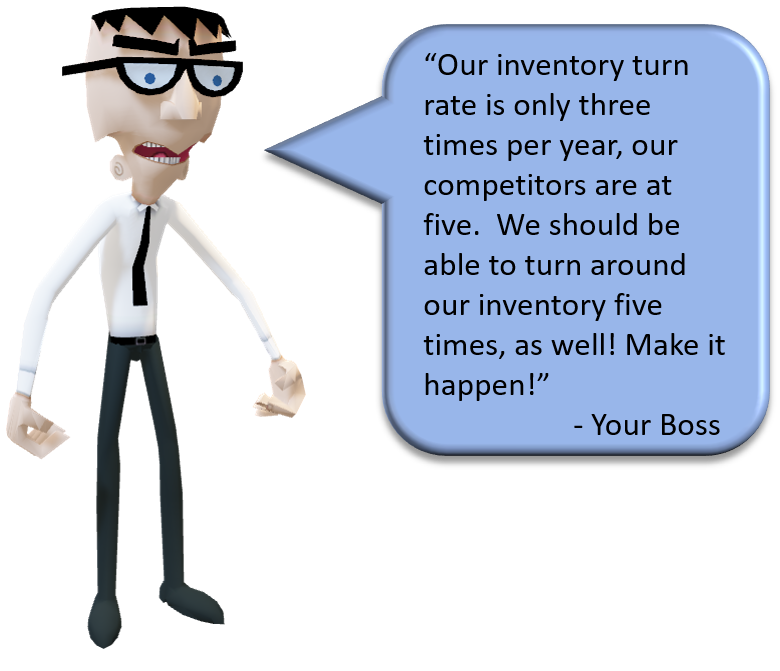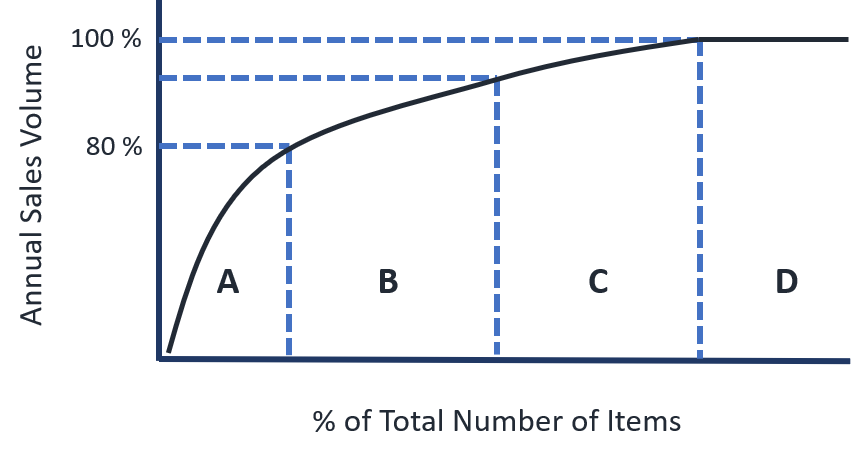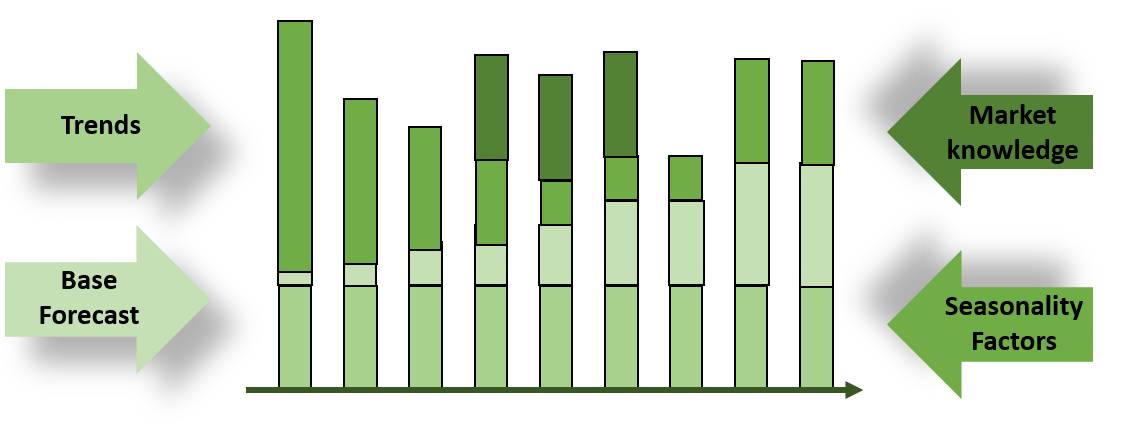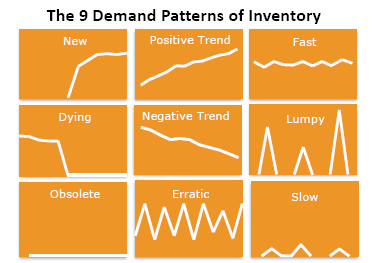
This is when the inventory reduction carousel starts. What is the easiest way to lower inventory? It is of course by reducing the stock level on the medium and fast movers. The inventory is reduced, and you achieve five turns per year. The big question is: at what price? When taking this approach, your expedited purchasing costs go up and service levels go down.
Why does this happen? Because there was a focus on a single supply chain key performance indicator (KPI); in this instance, the inventory turn rate. This is not too uncommon in most companies, and it can easily happen if a single problem rolls up on the management radar without them seeing the bigger KPI picture. Inventory reductions cannot be managed in a vacuum, and your inventory control cannot be done independently of the other variables and KPIs in your supply chain.
There are several questions you need to answer when creating a long-term winning strategy for fixing your inventory turnover challenges:
- What is your demand history and demand variability?
- What is your supply lead-time and lead-time variability?
- Do you have an efficient and effective supply chain design?
- Do your manufacturing capabilities and customer purchase characteristics align?
- Are you using the most cost-effective logistics for procurement and delivery?
- What is the right target service level for your business?
To achieve sustainable inventory reduction while maintaining or improving customer service, the variables that drive inventory must be improved. Too often, inventory is adjusted to meet financial goals, without understanding or improving the management of the variables that drive inventory levels.
Click here to view a video on the importance of inventory control.
Watching Inventory Levels
Why is your boss watching inventory levels like a hawk? Because it shows up directly on the company’s financial reports in a negative way. There is no line item on the balance sheet for tracking target service levels or forecasting accuracy.
The bottom line is that inventory is expensive, and it typically makes up 40% to 50% of a manufacturing or distribution organization’s capital investment. The cost is a combination of the value of the product and the storage costs associated with holding the inventory. It is usually a considerable number that the executive management team and shareholders see, and they do not like it.
There are several KPIs that need to be measured and managed simultaneously to obtain a holistic view of your inventory performance. The top KPIs and variables are service level, development of capital tied up in stock, inventory turnover, back-order recovery, and supplier performance.
The key to sustainable inventory reductions is to focus on the input variables. However, remember, that the overarching goal of the organization is to maximize long-term profits. Any attempt to reduce inventory should be in harmony with this goal.
We will now discuss the 7 ways that distributors and manufacturers can better manage their inventory turnover to reduce inventory levels while increasing service.
1 – Inventory ABC Classification
When it comes to classifying your inventory, it is usually safe to follow the Pareto Principle, also known as the 80/20 rule. The Pareto Principle is a theory that states ‘…where most businesses see 80% of their sales come from ±20% of customers’.
The ABC Classification for inventory management is a similar approach. Classifying your inventory items into A, B, C, and D (80%, 15%, 5%, 0%), based on sales volume is an industry best practice when managing inventory.
The most common metric to use is your Annual Sales Volume when doing ABC Classification to calculate your inventory for each group. For example, if you run the calculation and you’re A items represent 50% of your inventory, you may not have enough inventories for these items to meet customer demand.
Special consideration needs to be taken for new and critical items in your inventory. For new products, it is an option to use yearly forecast estimates to support demand estimates. For critical inventory items, you need special monitoring, so you do not run out of stock on essential items that might result in customers turning elsewhere.

2 – Revised Purchase Order Cycles and Quantities
Another effective strategy for managing inventory turnover better is to buy smaller quantities and order more often to reduce the overall inventory you carry. Can your warehouse and staff manage more frequent purchase cycles? Can capacity loss be offset by running lower-demand parts less frequently? Will there be any loss of transportation productivity by moving to smaller batches?
Determining order frequencies is one of the key variables of your supply chain. One way can be to stay at the same number of annual orders, but reallocated between the A, B and C principles, and at the same time evaluate the demand frequency, to more intelligently manage your order cycles and order quantities.
This strategy gives inventory managers more flexibility to align buying patterns with actual customer demand.
3 – Improved Inventory Forecasting and Forecast Accuracy
Forecasting is not always the most popular subject for inventory planners and managers, but there is no escaping the conversation, as forecasting is done by every make-to-stock or purchase-to-stock company. What we know to be true with inventory forecasting is that it is rarely accurate. It is possible to improve your forecasting, but most companies make the mistake of starting with mathematical forecasting methods, which should be the last step in the process.
Inventory forecasting best practices should begin with ensuring your data accuracy first. For example, sales and marketing may have been influencing your demand through pricing and promotion activity. First, you must understand and collect the inputs that drive the core of your demand. Separate out-seasonality and trends. Have the outliers filtered away and separate your base demand from campaign-driven demand.
Use the demand that is as close to real customer demand as possible, preferably point-of-sales data. If you forecast off of shipments, and the shipments don’t reflect true customer-order quantity and dates (based on unavailability and backorders), the data is tainted and will skew your forecasting.

When you have the right inputs, and the data is clean, THEN it is time to review forecasting methods. Ensure that you keep all data up to date as the products move through their product lifecycles. It is important to understand that forecasting accuracy will need ongoing analysis and calculation. By calculating your forecast accuracy on a regular basis, you provide your organization with a tool that will ensure accurate forecasts are made based on accurate demand patterns.
4- Estimate Excess and Obsolete Stock Levels
Do you know how much obsolete stock is kept on hand in your facilities? Is it kept because the company cannot ‘afford’ an expense hit this quarter to write off obsolete stock? Once your inventory reaches the obsolete stage of its life cycle, it is typically too late to take actions that will result in a profitable return on that investment. With good inventory policies in place, a better understanding of real customer demand and product life-cycle trends, companies can avoid this type of situation.
Warning: if you do not address obsolete stock, it will just continue to grow. Do not let accounting drive poor operating rules. Get obsolete inventory off the books and use that open space for productive and profitable inventory. If you identify excess stock (stock you have too much of on hand) compared to your forecasted demand, try to accelerate sales with the help of your marketing and sales teams before it becomes obsolete.
5 – Understand Your Customers’ Service Level Needs
What kind of service in terms of lead-time and availability do your customers require? It is no use to provide a higher service than required, as it costs your company money. Understand how your customers are using your products and what they expect in availability and delivery time. If a 7-day lead-time is good enough for your customer, then you might be able to lower your inventory levels and rely heavier on smaller expedited orders to save on inventory storage costs.
However, in today’s competitive environment, you cannot forget that the customer is king. If you do not deliver sales orders promptly, your customers will not hesitate to jump to one of your competitors. You just might find that you must shorten lead times and increase the availability of your inventory just to keep up with your competitors. Whatever the case, understanding your customers’ needs is critical to your success.
6 - Reduce the Variability of Your Demand
Does your organization struggle with reducing/eliminating large end-of-period buys (that were only there to meet quotas)? This is an extremely difficult habit to break and requires support all the way to the top of your organization if there is to be lasting, sustainable change.
One of the ways to steady-out demand variability is to analyse and study the largest spikes in your historical demand. What caused them, and did they have a negative impact on your sales and service delivery?
If you can identify the different demand patterns and alter these patterns in the future, your volatility will be much more predictable. In turn, your forecasting, planning, and replenishment practices will become more controlled and manageable.

Variability is highly-correlated with lead time, thus, shorter lea- times have less variability. Identifying your demand volatility, and discovering the cause, will help you plan to reduce that variability better, which in turn will help you lower inventory levels and costs.
7 – Align Your Company KPI Measurements
Does it always seem like leadership, finance, operations, and sales are on different pages of the same book? Many organizations have departmental breakdowns when it comes to defining operational success.
Let us look at an example:
1. The inventory planning manager’s payment is based on having low quantities of finished goods in inventory. He likes low inventory in the warehouses because management is happy with the reduction in capital costs. Lower inventory levels, are good for the organization, right?
2. On the other hand, we have the sales manager that wants everything in the warehouse so that when that new big sales order comes in, everything is available, because she is compensated for selling more products. Increased sales, are good for the organization, right?
3. Then we have the production manager who gets a bonus based on operational efficiency. The production manager likes long stable production runs resulting in lowering the unit cost by increasing the overall equipment efficiency and workforce utilization. Good for the organization, right?
Do you see the conflict?
The competing performance measurements result in the production manager disregarding short production cycles, to produce excess stock to get his production up. The inventory manager will not accept the goods at the warehouse because he does not want finished goods inventory going up and inflating his carrying costs.
Inventory is stored off-site or in trailers at the plant as a result. The sales manager inks a big deal, but the stock is not available at the warehouse, so it is expedited from another plant or an off-site location, risking the loss of the sale. The bottom line is everyone gets his or her bonus, but the supply chain is anything but efficient.